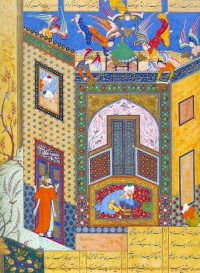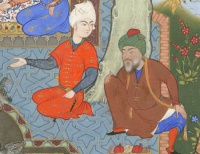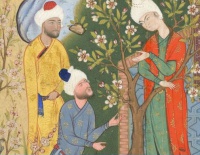Jami: Difference between revisions
Added the page to the "Poets" category |
Recategorized the page from "Persia" to "Persian literature" |
||
| Line 69: | Line 69: | ||
[[Category:Authors]] | [[Category:Authors]] | ||
[[Category:Poets]] | [[Category:Poets]] | ||
[[Category:Persian literature]] | |||
[[Category:1414 births]] | [[Category:1414 births]] | ||
Revision as of 02:50, 15 February 2018

Nur ad-Din Abd ar-Rahman Jami (Persian: نورالدین عبدالرحمن جامی) (August 18, 1414–November 19, 1492) was one of the greatest Persian poets in the 15th century and one of the last great Sufi poets of Persia. His fame rests even more on his mystical authority than on his talents as a poet and writer.
Biography
He was born in a village near Jam, but a few years after his birth, his family migrated to the cultural city of Herat in present-day Afghanistan where he was able to study Peripateticism, mathematics, Arabic literature, natural sciences, and Islamic philosophy at the Nizamiyyah University of Herat.
Afterwards he went to Samarqand, the most important centre of scientific studies in the Islamic World and completed his studies there. He was a famous Sufi, and a follower of the Naqshbandiyyah Sufi Order. At the end of his life he was living in Herat.

From the Haft Awrang of Jami, in the story "A Father Advises his Son About Love." See Nazar ill'al-murd Smithsonian Institution, Washington, DC.
Teachings
In his role as Sufi shaykh, Jami expounded a number of teachings regarding following the Sufi path. In his view, love was the fundamental stepping stone for starting on the spiritual journey. To a student who claimed never to have loved, he said, "Go and love first, then come to me and I will show you the way."[1]
Works

Another illustration from the Haft Awrang
Jami wrote approximately eighty-seven books and letters, some of which have been translated into English. His works range from prose to poetry, and from the mundane to the religious. He has also written works of history. His poetry has been inspired by the ghazals of Hafez, and his Haft Awrang is, by his own admission, influenced by the works of Nezami.
Divan of Jami
Among his works are:
- Baharestan (Abode of Spring) Modeled upon the Gulestan of Saadi
- Diwanha-ye Sehganeh (Triplet Divans)
- Al-Fawaed-Uz-Ziya'iya.[1]
- Haft Awrang (Seven Thrones) His major poetical work. The fifth of the seven stories is his acclaimed "Yusuf and Zulaykha", which tells the story of Joseph and Potiphar's wife based on the Quran.
- Jame -esokanan-e Kaja Parsa
- Lawa'ih A treatise on Sufism (Shafts of Light)
- Nafahat al-Uns (Breaths of Fellowship) Biographies of the Sufi Saints
- Resala-ye manasek-e hajj
- Resala-ye musiqi
- Resala-ye tariq-e Kvajagan
- Resala-ye sarayet-e dekr
- Resala-ye so al o jawab-e Hendustan
- Sara-e hadit-e Abi Zarrin al-Aqili
- Sar-rešta-yetariqu-e Kājagān (The Quintessence of the Path of the Masters)
- Shawahidal-nubuwwa (Distinctive Signs of Prophecy)
- Tajnīs 'al-luġāt (Homonymy/Punning of Languages) A lexicographical work containing homonymous Persian and Arabic lemmata.[2]
- Tuhfat al-ahrar (The Gift of the Nobel)[3]
Along with his works are his contributions to previous works and works that have been created in response to his new ideas.[4]
See also
Notes
- ↑ شـرح مـلا جـامـي - Sharh Mulla Jami. Arabicbookshop.net. Retrieved on 2014-08-05.
- ↑ Shīrānī, 6.
- ↑ Tuhfat-ul-Ahrar by Maulana Jami (Persian) : Maulana Abdul Rahman Jami : Free Download & Streaming : Internet Archive. Archive.org (2001-03-10). Retrieved on 2014-08-05.
- ↑ Rahman, Fazlur (1966). Islam. Holt, Rinehart, and Winston.
References
- E.G. Browne. Literary History of Persia. (Four volumes, 2,256 pages, and twenty-five years in the writing). 1998. ISBN 0-700-70406-X
- Jan Rypka, History of Iranian Literature. Reidel Publishing Company. ASIN B-000-6BXVT-K